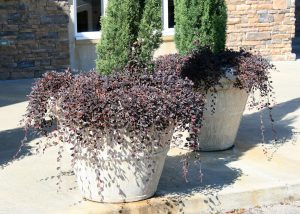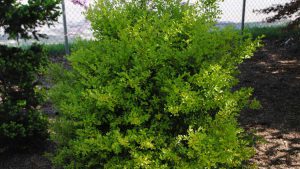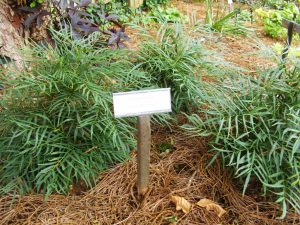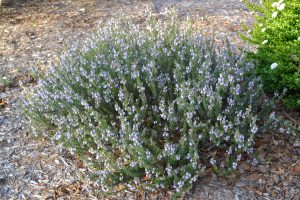by Daniel J. Leonard | Aug 11, 2017
Growing in containers can be one of the most versatile ways to add color, texture and mobility to the landscape. However, gardeners generally reach for finicky annuals to fill their pots with pizzazz. The problem with this strategy is that most annuals and perennials need to be watered constantly, fertilized regularly, and changed out with the seasons. That sounds like a little bang for a whole lot of buck! I and most of the real plant people I know fall squarely in the school of lazy gardening and believe there is an easier, less intensive, and ultimately less expensive way to get the same result. This can be accomplished by thinking outside the box and using an alternative class of plants that can fit the same bill of providing color and texture in pots without the headaches and have been sitting on the shelves right in front of us the whole time, the shrubs.
It is beyond me why shrubs aren’t used as container plants more often. Maybe the reason for the lack of use is pure perception; after all, no one with any sense would plant a giant, coarse green meatball or an enormous antebellum azalea in a decorative pot on their front walk. Recent innovations by plant breeders have left this argument moot though as new introductions of old species have revived interest in the entire group. Many of the best of these new cultivars sport traits perfect for container culture (dwarf growth habit, increased flowering, and interesting texture and form) while preserving the ironclad, undemanding nature of their parent plants. The following are a few of my favorite new shrub introductions for container growing!
- ‘Purple Pixie’ Loropetalum

Purple Pixie loropetalum is a low-growing shrub that can spill beautifully out of a container. (Photo by MSU Extension Service/Gary Bachman)
If interesting architecture is what you require in a plant, ‘Purple Pixie’ must be on display in your yard. This dwarf cultivar of the wildly overused purple shrub Loropetalum chinense has taken the horticultural world by storm. The unique combination of true purplish foliage that only greens slightly in the hottest summer sun, ribbon-like pink spring flowers, and a graceful weeping habit make ‘Purple Pixie’ a winner. Give this plant a medium sized container (at least 12” in diameter), water when the soil begins to dry, fertilize infrequently with a slow-release formulation, site in full sun to partial shade, and enjoy for many seasons to come.
This is definitely not your granddaddy’s Ligustrum. Gone are the rampant growth, sickly sweet smelling flowers, and the aggressive nature of ‘Sunshine’s’ parent Chinese Privet (Ligustrum sinense). ‘Sunshine’ is a sterile cultivar with dwarf characteristics (growing 4-5’ with infrequent light pruning), vivid yellow-chartreuse foliage, and most importantly, no flowers. All ‘Sunshine’ asks of us is plenty of sun, occasional fertilizer and a light haircut once or twice a season! Use this plant to frame a dark flowerbed or in a container as a companion to the previous plant, ‘Purple Pixie’ Loropetalum for an extremely striking combination!

‘Sunshine’ Ligustrum. Photo courtesy of JC Raulston Arboretum.
A new take on a landscape standard, ‘Baby Gem’ is an exceptionally compact and slow growing cultivar of Buxus microphylla var japonica. All the same features gardeners love about traditional “full-size” boxwoods remains (tight, formal growth habit, ability to prune into many different shapes and ironclad constitution) but with ‘Baby Gem’ are delivered in a perfect package for a pot. This little “gem” of a plant is perfect for use in a smallish container to frame a formal landscape or to give a sense of order to an informal container garden or border!
So if you’re ready to stop replacing all of your potted plants each and every season, reach for one of these shrubs the next time you are at a garden center. You’ll likely be rewarded with compliments on your creativity, four season interest from the plants themselves, and more time to enjoy being in your garden instead of laboring in it! As always, if you have any questions about this or any other horticultural topics please contact your local UF/IFAS Extension office! Happy Gardening!

by Julie McConnell | Jul 12, 2017

Coontie (Zamia floridana) planted at the same time but growing at different rates. Photo: J_McConnell, UF/IFAS
When designing landscapes, it is popular to create lines and masses of plants for high visual impacts. Plants are carefully selected to be similar in size and shape at the time of installation. They are all grouped together, so they must be getting the same care, but why do they look different years later? There are several factors to consider when we are trying to figure out why a perfectly matched set no longer looks like a uniform planting.
Although plants may be in the same bed, shadows cast at certain times of the day may reduce sunlight to some sections and not others. This can be caused by structures or trees that have grown over time and changed light patterns.
Supplemental irrigation may also be variable even with the best system design. Over time plants grow and may block sprinkler emitters from reaching some sections of landscape beds. Even if the landscape relies on natural rainfall, there can be still be dry/wet spots in the landscape due to drainage off of hard structures, low areas, or wind direction during storms.
It might be possible to adjust some lighting and watering issues, but there is one factor that many gardeners have not considered – genetics. If plants were grown from seed, than variation is not only possible, but likely. This might be displayed as differences in height and width, foliage color, flower color, speed of growth – all may be influenced by parentage despite best efforts to care for each plant similarly.
Many landscape plants are cultivars. This means they are grown from cuttings or divisions which make them identical to the original plant. When a plant is grown from seed, however, there is no guarantee it will have the same specific qualities as the mother plant.
To combat this phenomenon, landscapers should check sunlight and watering for irregular growth patterns and adjust if needed. If a landscape design requires uniform plants, use named cultivars rather than seedling grown plants in lines or masses.

by Gary Knox | Jun 29, 2017

IPM for Shrubs in Southeastern US Nursery Production Volume II is the third book released by the Southern Nursery Integrated Pest Management Working Group (SNIPM) and includes chapters on hydrangea, loropetalum, holly, rhododendron (including azalea), Indian hawthorn, and weed management. Each chapter covers history, culture and management of the major species and cultivars in production, as well as arthropod pest management and disease management. Within the discussion of these topics, each chapter includes strategies for developing effective IPM programs for key pests and plant pathogens, including tables of fungicides and insecticides for use with these key organisms. While developed for nursery producers, this information also may be useful to landscapers, students, arborists and others.
This free book is downloadable as pdf chapters at
http://wiki.bugwood.org/IPM_Shrub_Book_II.
The first book, IPM of Select Deciduous Trees in Southeastern U.S. Nursery Production, was released in May 2012 and is available for free download as chapter .pdf files at http://wiki.bugwood.org/SNIPM and as an eBook from the iTunes Bookstore https://itunes.apple.com/us/book/ipm-for-select-deciduous-trees/id541182125?mt=11.
The second book, IPM for Shrubs in Southeastern US Nursery Production Volume I, was released in June 2014 and can also be downloaded as chapter .pdf files at http://wiki.bugwood.org/SNIPM or from the iTunes Bookstore at https://itunes.apple.com/us/book/ipm-for-shrubs-in-southeastern/id903114207?mt=11.
The SNIPM Working Group is a multi-disciplinary group of Extension professionals formed to more efficiently and effectively develop and deliver educational programming to the southern U.S. nursery and landscape industry.
by Daniel J. Leonard | Apr 24, 2017
Almost every landscape has a problem area where the sun just doesn’t shine and many plants won’t make it, maybe it’s the north side of your house, under a small tree, or tucked away in an oddly-shaped alcove. We all know the same old boring green choices that work well here (Holly Fern, Cast Iron Plant, etc.) but maybe you want something a little bit different, something that will provide a pop of color and interesting texture! Look no further than a recent introduction, a whole-plant mutation discovered from the little-used Grape Holly (Mahonia spp.), aptly named ‘Soft Caress’.
‘Soft Caress’ Mahonia is a beautiful little evergreen shrub from the Southern Living Plant Collection (one of the best of the collection in my opinion) and really is a game changer for full-shade areas. Some of you may remember the traditional Mahonia, also known as Grape Holly, from your grandmother’s lawn. Those plants were coarse, spiny, produced messy purplish berries and often appeared generally unkempt. ‘Soft Caress’ is a major departure from its parent. Possessing finely-cut, deep green, bamboo-like foliage, this plant’s texture really contrasts well with many traditional shady species. As a bonus, ‘Soft Caress’ sends up brilliant yellow-gold flower spikes in the dead of winter, certainly a welcome respite from the other barren plants in the landscape; although in this unusually warm year, the plants are just now blooming in the Panhandle.

Photo courtesy: Daniel J. Leonard
‘Soft Caress’ is advertised to grow three feet in height and width, a more manageable size than the larger traditional Mahonia species, but I’m not sure I’d take that as gospel, the three-year old plants (hardly mature specimens) in my parent’s landscape are already that size and show no signs of slowing down. However, I’ve found you can easily manage their size with a once a year prune to slow down some of the more rapidly-growing canes. Be sure to time the prune as soon as possible after flowering is finished as ‘Soft Caress’ blooms only once a year and produces its flowers on the previous season’s wood, just like Indica Azaleas and old-fashioned Hydrangeas.
The uses in the landscape for ‘Soft Caress’ Mahonia are nearly endless. It pairs well with almost anything in a shady mixed shrub border. It works nicely as a foundation plant against a porch or under windows on the north or east side of a house where it will be protected from hot afternoon sun; I have employed a grouping of the plants in this way in my own lawn with success. It even thrives in containers! If you want to show off some serious horticultural design skills, mix ‘Soft Caress’ in a large container on the porch with some like-minded perennials for a low-maintenance, high-impact display that you don’t have to replant each season. All this shrub requires is partial to full shade, moist well-drained soil, and an occasional haircut to keep it looking tidy! If you’ve been struggling to find a plant that’s a little more unusual than the standard garden center fare and actually looks good in shady spots, you could do a lot worse than ‘Soft Caress’ Mahonia. 
As always, happy gardening and contact your local UF/IFAS County Extension office for more information about this plant and other gardening questions!

by Beth Bolles | Mar 30, 2017
We often talk about sandy, nutrient poor soil in Florida and how difficult it is for growing many favorite landscape plants. Gardeners may spend considerable time and money amending soils with organic matter to improve quality.
The low maintenance approach is to embrace your sandy soil and consider plants that thrive in sandy, well-drained soil. One very attractive native shrub that actually prefers this type of soil is false rosemary, Conrandina canescens.
False rosemary is a member of the mint family that is well adapted to drier, sandy soils. It can be found in many coastal communities growing in natural areas. It is easily recognized in the spring and early summer by light purple blooms. Considered a small shrub or groundcover, False rosemary needs full sun. One plant can easily spread out to 4-5 feet in diameter with a height of 2-3 feet.

False rosemary is an attractive native plant for Gulf Coast landscapes. Photo by Beth Bolles, UF Escambia County Extension
False rosemary does have aromatic foliage and is attractive to bees. It is a very low maintenance plant once established and its few issues tend to be related to soils with too much moisture and plants being shaded after establishment. New seedlings will emerge around the main plant when growing conditions are right. If you want to try this native plant in your landscape, talk to a local nursery.

False rosemary flowers are attractive to pollinators. Photo by Beth Bolles, UF Escambia County Extension










